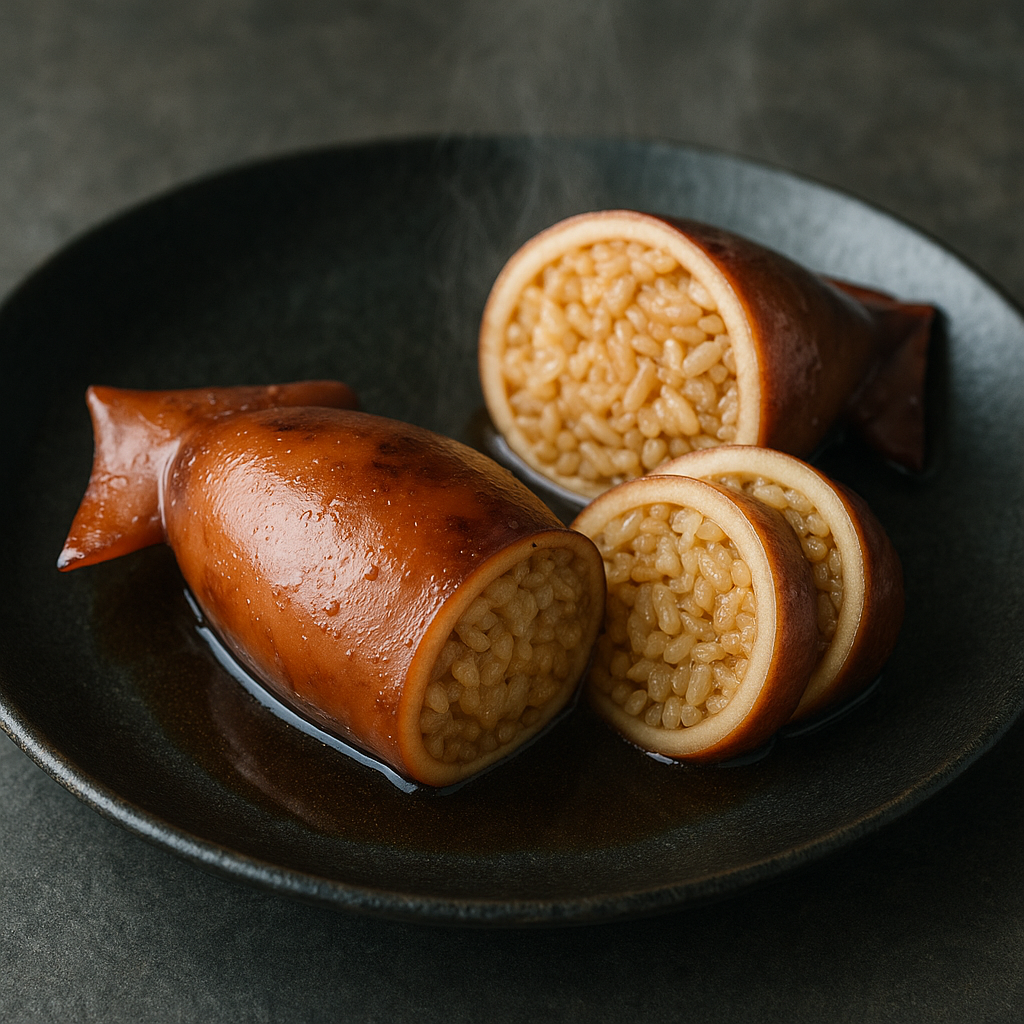いかめしの特徴
北海道の駅弁発祥料理
いかめしは、北海道森町発祥の郷土料理で、イカの胴にもち米やうるち米を詰めて煮込んだ料理です。駅弁として有名になり、全国的に知られる存在となりました。
イカと米の旨味の融合
イカの旨味が米に染み込み、米の食感とイカの柔らかさが調和した独特の味わいが楽しめます。醤油や砂糖を使った甘辛い味付けが定番です。
保存性と携行性
煮詰めることで保存性が高まり、駅弁や旅行の携行食として重宝されてきました。冷めても美味しく食べられるのが特徴です。
いかめしのレシピ
材料(4人分)
- スルメイカ(中サイズ) … 4杯
- もち米 … 1/2合
- うるち米 … 1/2合
- 醤油 … 50ml
- みりん … 40ml
- 酒 … 40ml
- 砂糖 … 大さじ2
- だし汁 … 200ml
- 生姜(薄切り) … 数枚
作り方
- もち米とうるち米を研ぎ、30分ほど浸水させて水を切る。
- イカは足と肝を取り出し、胴の中をきれいに洗う。
- 米をイカの胴に7分目まで詰め、楊枝で口を留める。
- 鍋にだし汁・醤油・みりん・酒・砂糖・生姜を入れて煮立て、イカを加える。
- 落し蓋をして弱火で40〜50分煮込み、味を染み込ませて完成。
シェフのワンポイントアドバイス
米は詰めすぎると炊き上がりに膨張してイカが破けるため、7分目程度に抑えるのがポイントです。
煮込んだ後、しばらく置いて味をなじませるとより美味しくなります。
イカの足を刻み、イカの肝の中身を絞り、ご飯に混ぜ込むと非常に旨味が強くなりますが、同時にクセが出てくるのでお好みで。
いかめしの栄養価(1人分の目安)
- エネルギー:約300〜400 kcal
- たんぱく質:20〜25 g
- 脂質:5〜8 g
- 炭水化物:50〜60 g(米由来)
- タウリン(イカ由来、疲労回復に効果)
- ビタミンB群(イカ・米由来)
イカの高たんぱく質とタウリンに加え、米のエネルギー源も摂れる栄養バランスの良い料理です。
いかめしの歴史
森町駅弁としての誕生
第二次世界大戦中、米不足を補うために考案されたのが「いかめし」で、北海道森町の駅弁として販売され人気を博しました。
保存食・携行食として
冷めても美味しく食べられることから、駅弁や旅行食として広く普及しました。
全国的な知名度
現在では駅弁大会などでも人気を集め、北海道を代表する郷土料理・名物駅弁として全国的に知られています。
English Version
Features of Ikameshi
A Station-Bento Dish from Hokkaido
Ikameshi is a traditional dish from Mori Town in Hokkaido, where squid is stuffed with glutinous rice and regular rice, then simmered in a savory-sweet sauce. It became famous as a station bento and is now known throughout Japan.
Harmony of Squid and Rice
The flavor of the squid permeates the rice, creating a unique balance between the tender squid and the chewy rice. A soy sauce and sugar-based seasoning is the standard.
Preservation and Portability
By simmering, the dish gains longer shelf life and was valued as a bento or travel food. It remains delicious even when eaten cold, which is one of its defining features.
Ikameshi Recipe
Ingredients (for 4 servings)
- Squid (medium-sized) … 4
- Glutinous rice … 1/2 cup
- Regular rice … 1/2 cup
- Soy sauce … 50 ml
- Mirin … 40 ml
- Sake … 40 ml
- Sugar … 2 tbsp
- Dashi … 200 ml
- Ginger (sliced) … a few pieces
Instructions
- Rinse the glutinous and regular rice, soak for 30 minutes, then drain.
- Clean the squid, removing the legs and innards, and wash the body thoroughly.
- Stuff the rice into the squid body up to about 70% full, then seal the opening with a toothpick.
- Bring dashi, soy sauce, mirin, sake, sugar, and ginger to a boil in a pot, then add the squid.
- Cover with a drop lid and simmer gently for 40–50 minutes until the flavor is absorbed.
Chef’s Tip
Do not overfill the squid with rice, as it will expand during cooking and may burst the body—about 70% full is ideal. Let the squid rest after simmering to allow the flavors to settle. For deeper flavor, you can finely chop the squid legs and mix in the liver before stuffing, but this will also add a stronger taste.
Nutritional Value (per serving, approx.)
- Calories: 300–400 kcal
- Protein: 20–25 g
- Fat: 5–8 g
- Carbohydrates: 50–60 g (from rice)
- Taurine (from squid, supports recovery)
- B vitamins (from squid and rice)
A well-balanced dish combining high protein and taurine from squid with energy from rice.
Historical Background
Birth as a Station Bento in Mori Town
Ikameshi was invented during World War II to make up for rice shortages. It was sold as a station bento in Mori Town, Hokkaido, and quickly became popular.
As a Preserved and Portable Food
Its ability to stay tasty even when cold made it a practical bento and travel food, leading to wide adoption.
National Recognition
Today, ikameshi is celebrated at bento fairs and remains one of Hokkaido’s most iconic local specialties and railway station dishes.



何でも質問してください!